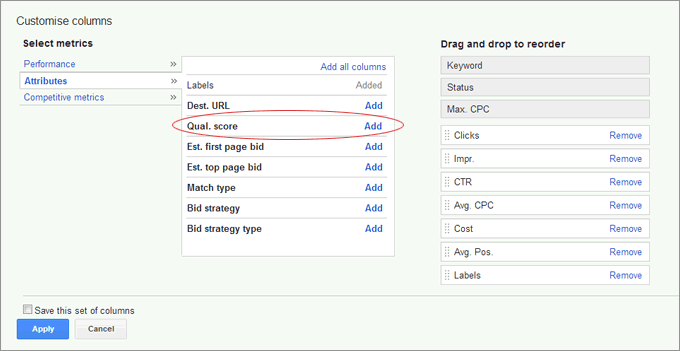If you’ve used Google Adwords at all then there’s a good chance you’ll have heard of the term “Quality Score”. It’s one of those AdWords related terms that often doesn’t mean much to the AdWords beginner, but starts to have more significance as the beginner tries to optimise their AdWords campaigns.
Unfortunately, despite the improvements it can generate, Quality Score is not one of the default stats provided within the Google Adwords interface. Users have to manually add the column to their reports, or hover over an icon to see scores, hence why many don’t start to use it until they are beyond the beginner stage.
What is Google Adwords Quality Score?
Simply put, Quality Score is a measure of how relevant Google believes your campaigns are to the person who sees them. For instance, how closely does your keyword match what the user searched for? Does you Ad content relate to the users search? Is the resulting landing page on your site related to what the user was looking for?
Quality Score is an estimate of how relevant your ads, keywords and landing page are to a person seeing your ad. Having a high Quality Score means that our systems think your ad, keyword and landing page are all relevant and useful to someone looking at your ad.
(Taken directly from Google AdWords Support area: https://support.google.com/adwords/answer/2454010?hl=en-GB)
How do your keywords currently score?
The longer term tactic is to have high Quality Scores on as many of your keywords as possible. The shorter term tactic is simply to find out what your current scores are, so you can prioritise which keywords to improve first.
Viewing Quality Score: Method 1
Drill down to the keyword level of one of your Campaigns by clicking on a campaign, then on one of the resulting AdGroups. At this point you should see a list of your keywords on the page. You’ll notice that one of the default columns is titled “Status” and, within it, the status should be listed as “Paused”, “Eligible” or “Disapproved”. Within each cell you should see a small speech bubble icon. Hover over it. This will display a score out of 10. This is your Quality Score for that keyword.

Viewing Quality Score: Method 2
While Method 1 provides a little more information than method 2, method 2 makes it quicker to glance at Quality Scores for all keywords. Having drilled down to keyword level, click on the Columns drop down menu and select “Customise Columns”. Select Attributes, and then press “Add” next to Quality Score. Press Apply. You should now find that a Quality Score column has been added to the report.

Improving Quality Score CAN impact your campaign performance
The main benefit to improving quality score is cost. Keywords with higher Quality Scores generally have lower Costs Per Click (CPC). Simply put, you’ll gradually pay less per click for keywords with higher quality scores, meaning your AdWords budget should gradually generate more clicks for you.
Additional benefits relate largely to how and where you Ads appear. Keywords with higher Quality Scores often result in Ads being displayed higher up the page, potentially increasing the volume of clicks that Ad will receive.
In a nutshell, higher Quality Scores typically lead to lower costs and better ad positions. Relevant ads tend to earn more clicks, appear in a higher position and bring you the most success.
(Taken directly from Google AdWords Support area: https://support.google.com/adwords/answer/2454010?hl=en-GB)
Improving low Quality Scores within your AdWords account
Improvement has to start somewhere, and often the best place to start is to look at the relevancy of your Campaigns, AdGroups, Keywords, Ads and Landing Pages.
For example, imagine you sell Brown Tables. Some questions to ask might be …
- Are our Brown Table related keywords grouped within a Brown Table themed AdGroup, or are they mixed in with various other keywords (red tables, metal tables etc)?
- Do our Ads within this targeted AdGroup mention, or relate to, Brown Tables? Or have we used the same generic Ad in all our AdGroups?
- When users click on our Ad, are we taking them to a page about Brown Tables, or are we taking everyone to our website homepage?
Google itself outlines various factors that it looks at when calculating Quality Score, suggesting that improvement of them will result in improved Quality Score. Some of those factors include:
- The quality of your landing page: How relevant, transparent and easy-to-navigate your page is.
- Your keyword/search relevance: How relevant your keyword is to what a customer searches for.
- Your account history: The overall CTR of all the ads and keywords in your account.
- Your keyword’s past click-through rate (CTR): How often that keyword led to clicks on your ad.
What now?
If you already use Google AdWords, start investigating. Figure out what your current Quality Scores are, and look for areas that could be improved (better keyword targeting? Better ads? Better landing pages?).
If you’re not already using Adwords, but are about to start, then make sure you take Quality Score into account when structuring your account.
As always, if you’d like assistance with your AdWords, we can help. Contact us to arrange a coffee and a chat!




